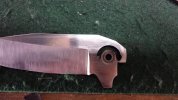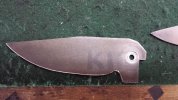nosaj750
Larevo Knives
- Joined
- Aug 28, 2010
- Messages
- 207
I'm in the process of trying to perfect a knife design I'm working on and when cutting the slot in the blade for the hidden stop pin should it be a complete 180 degrees? I ask because the last one I cut was too long. Luckily I didn't cut all the way thru the steel and left a bit to fit by hand and file down as needed otherwise it would have been a total loss. Should it be cut with only 170 deg? Can't seem to get my head around where the mistake is for some reason. Any suggestions or recommendations are very welcome. cutting with a 1/8 end mill on mini cnc mill. As you can see in the pics my mill doesn't cut circles exactly round, still trying to work that bug out but, it's getting closer. pics are the first blade I did and cut. the second is the new one I'm getting ready to cut but want to make sure it's right this time. at least try to make sure it's right...
thanks for the help.


thanks for the help.


